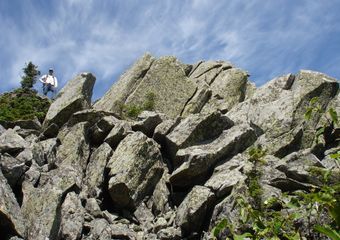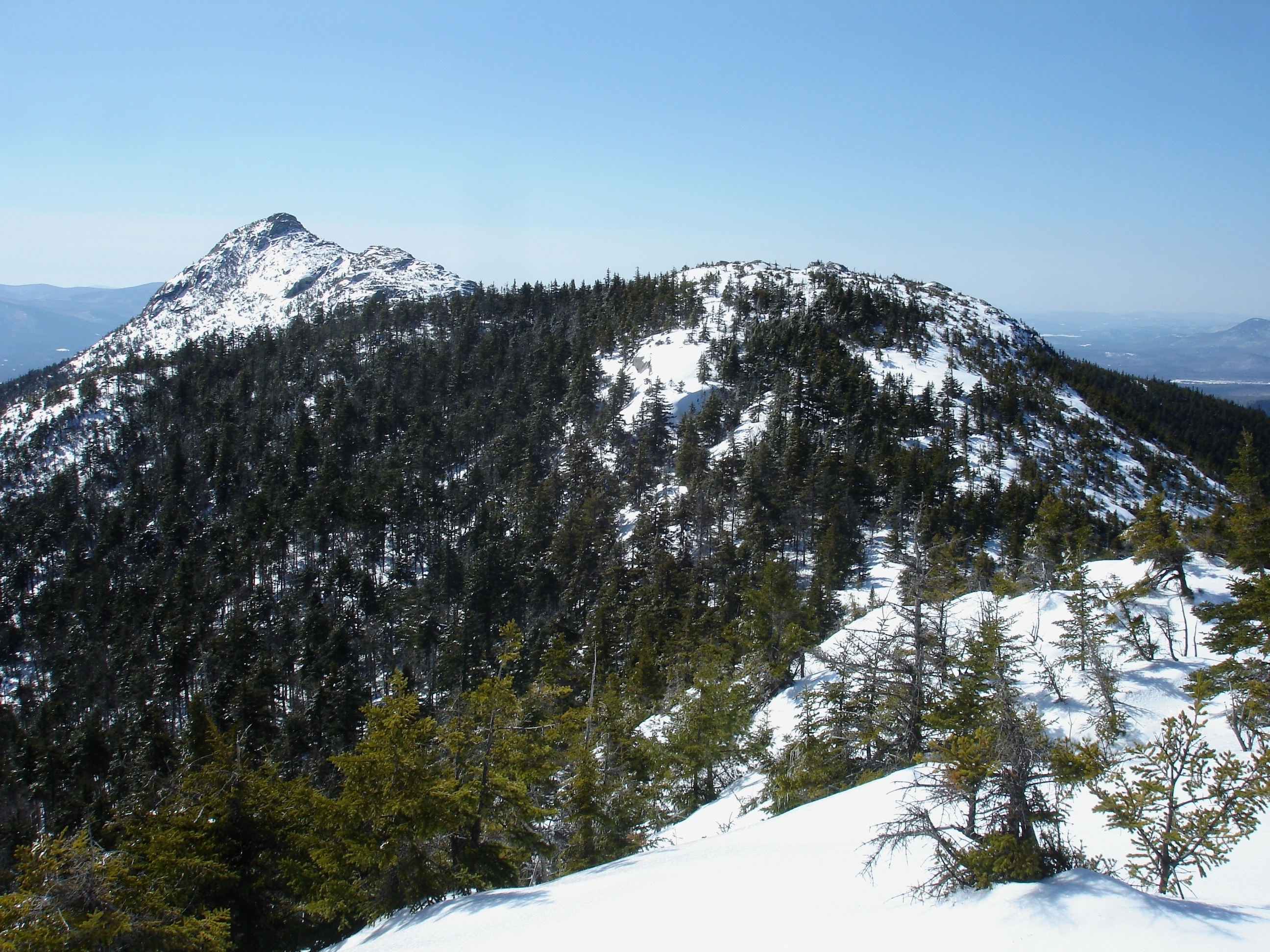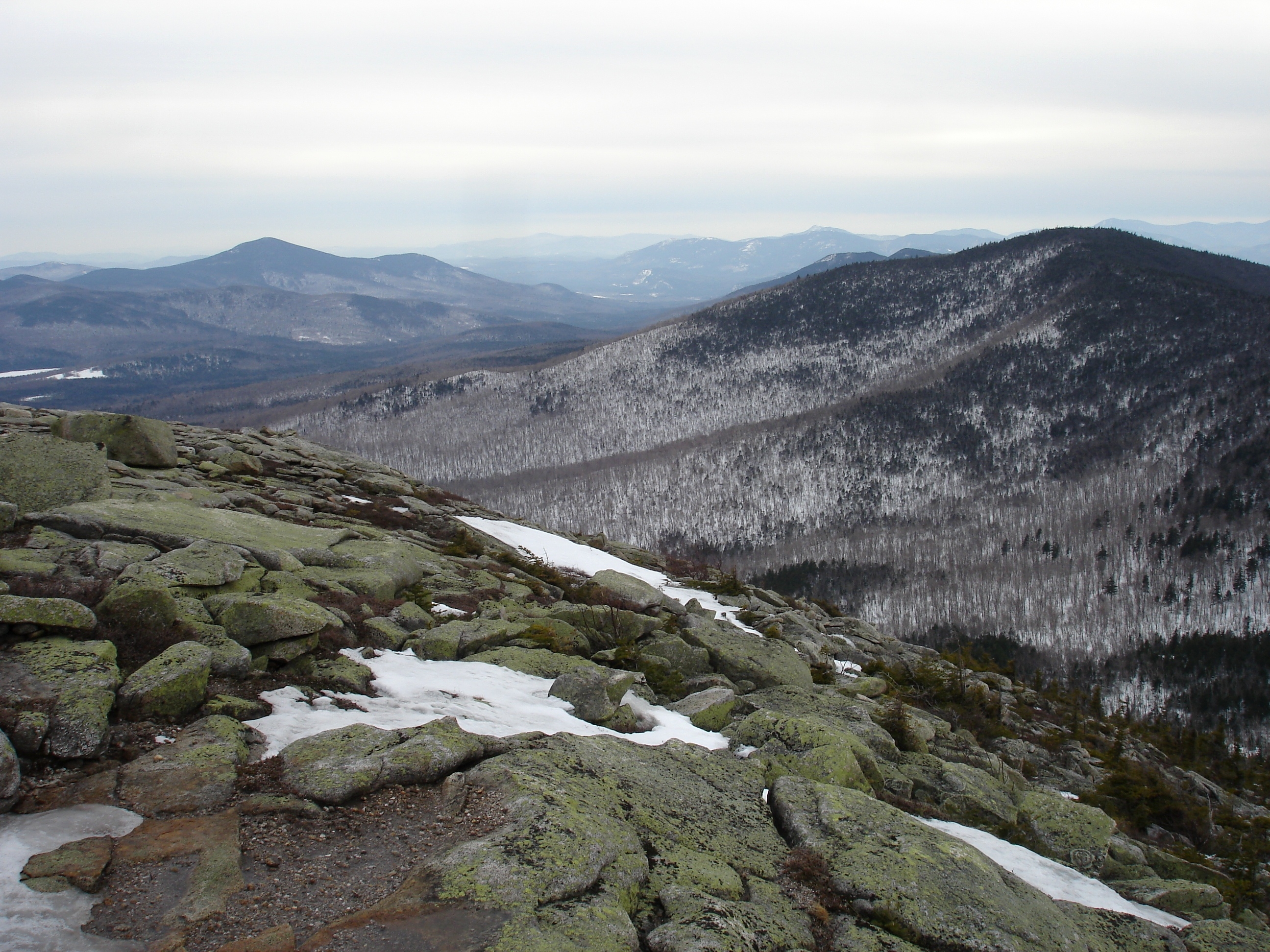A History of Northeast Peakbagging Part II: Winter
As the follow-up article to A History of Northeast Peakbagging I, this time we explore the antiquity of Northeast mountain climbing during winter. If you read that first article, you learned of three men–Bob Marshall, George Marshall, and Herb Clark–who kicked off the peakbagging craze in the early 1900s. And then you read of stoic hikers, the stuff of legend, really–Tom Sawyer, John Swanson, and John Person, among others–who took mountain climbing to levels not thought possible, tackling lists hundreds of mountains deep.
Old-time peakbaggers and those of today have had enough trouble getting to remote summits by pushing their way through scrub forests, not getting lost, and doing their best to outmaneuver hordes of antagonistic insects. For some, though, that’s just not enough of a challenge. No, the hardiest hikers add a one-word formidable qualifier to make it more arduous. That word is “winter.”
For those unfamiliar with this standard, the simplest definition of winter is: “not spring, nor summer, nor fall.” To claim a winter ascent, one must not begin their hike prior to the first moment of this season (which usually takes place on December 21) and must not end their hike after the last moment of this season (which usually takes place on March 21). As Robert and Miriam Underhill, the Northeast’s first winter peakbaggers, put it, ” ‘Snow on the ground’ and other namby-pamby criteria” does not make for a winter ascent. (Thus, contrary to what has been claimed, the Appalachian Trail has never been thru-hiked during winter.) So, dust off your snowshoes, wax your skis, and get ready for a wintertime peakbagging chronology that might send a shiver down your spine.
The Underhills were trendsetters when it came to Northeast winter peakbagging. It was Miriam Underhill who thought the dedication to winter criteria “would present an even more sporting challenge than ambling up the well-trodden trails in summer.” This husband and wife team set their sights on the 48 New Hampshire 4,000-footers. This list was first completed, non-winter, in 1948 by J. and Lillian McKenzie, another husband and wife team. But it was on December 23, 1960, that the Underhills finished the first-ever “winter round” of these peaks when they reached 5,712-foot Mount Jefferson, the third-highest peak in the state. The temperature on top was -8, and gusts of 70 miles per hour brought the wind chill down to -50. The day they summited Mount Jefferson, Miriam Underhill was 62. Robert Underhill was 71. Though nearly 15,000 people have climbed the New Hampshire 4,000-footers during spring, summer, or fall, fewer than 900 have taken the time to scale them during winter.

South face of 4,832-foot Carter Dome from 4,422-foot Wildcat Mountain, New Hampshire (Erik Schlimmer)
Though peakbagging began in the Adirondack Mountains during the early 1900s, it wasn’t until the 1960s that winter peakbagging took hold. On March 10, 1962, the “Adirondack 46” peaks were first climbed during winter, and the man to do it was Edgar Bean. He finished on 3,986-foot Blake Peak, formerly ranked a 4,000-footer. He had finished visiting all these peaks in 1955, but that was during spring, summer, or fall. Repeats of Bean’s feat were rare in the early days. During the 30 years that followed his accomplishment, an average of one hiker per year finished visiting all peaks during winter.
The “winter 46” are much easier to complete today than it was during Beans’ era. This is mostly due to advances in equipment and navigational tools, and with trip reports being commonly posted on the internet, lethargic winter hikers sometimes wait for other hikers to break out trails, thus enabling them to travel easily due to the persistent work of others. Nonetheless, of the more than 11,000 hikers who have finished this list of peaks non-winter, about 1,000 have reached all of them during winter.
The “little sisters of the Adirondack Mountains,” the Catskill Mountains, were the next venue for a winter peakbagging accomplishment. Circa 1968, this range’s peaks above 3,500 feet were climbed during winter by Ray Donahue. Overall, he was the 23rd person to hike these mountains during non-winter. I had the pleasure of speaking with Donahue, a reverend, a few times before he passed away in 2018 at the age of 90. The man was a gem, a true humanitarian. Regarding additional adventures among the mountains, in 1969, he, with Norman Greig, hiked the Adirondack 46 in nine days flat, a record at that time. Sharing his passion for the out-of-doors with several generations of hikers, he served as chaplain of Lake Delaware Boys Camp for 50 years.
During Donahue’s time, there were thought to be 34 Catskill summits above 3,500 feet. Decades later, another peak was “found,” bringing the total to 35. Winter peakbagging in this range is popular due to mild weather and the fact that all peaks can be day-hiked. Of the more than 3,000 people who have hiked the 35 peaks, about one-third of them have summited these mountains during winter.
With the 46 Adirondack 4,000-footers, 48 New Hampshire 4,000-footers, and 35 Catskill 3,500-footers each climbed during winter by the 1960s, it was time for someone to take on a winter list at least 100 peaks deep. The man to do it was Jim Collins. On the second day of 1971, he climbed Maine’s North Brother, in Baxter State Park to finish the Northeast’s 4,000-footers during winter. At that time, this list included 111 mountains. Today, due to more accurate surveys, there are 115. Collins was the second person to ever summit the Adirondack 46 peaks during winter. He finished that winter list in 1963, a year after Edgar Bean was first to do it. It is not known how many people have completed the Northeast 4,000-footers during winter, though 150 is a good guess. Nearly 1,000 people have climbed them during spring, summer, or fall.
Winter peakbagging during the 1970s was not for the faint of heart, and the tough times those hikers encountered cannot be replicated today. In Forest and Crag, Guy and Laura Waterman observed that “New England winter climbers accomplished some feats that are impressive when one recalls that they almost always broke out every trail they used; that many New England peaks with trails after 1970 were trailless before then; that the Kancamagus Highway was not plowed, making the peaks of the Pemigewasset far more remote; and that they climbed with such enormous packs.”
Nonetheless, the indefatigable New England peakbagger Tom Sawyer finished climbing New Hampshire’s 100 highest peaks during winter when he reached 3,565-foot Mount Success on February 24, 1979. As Sawyer remembered, most peakbaggers back then thought the idea of climbing the 100 highest peaks of any part of New England to be “impossible or insane.” This list, topped by 6,288-foot Mount Washington, bottoms out among four peaks that each have elevations of 3,500 feet. Though accurate figures are difficult to come by, it is certain that fewer than 100 hikers have completed this winter list.
Sawyer was a man on a mission. A week after his New Hampshire 100 highest finish, he summited Maine’s 3,795-foot Mount Coe to become first to climb New England’s 100 highest peaks during winter. Of the 1,025 people recorded as having summited these peaks, 120 are recorded as having reached them during winter.
Next to place his snowshoe tracks on some of the most remote peaks in New England was Deane Morrison. On March 11, 1984, he finished climbing the 175 New Hampshire 3,000-footers during winter. About a year later, he became first to climb New Hampshire’s 200 highest peaks during winter, finishing on 2,965-foot Rogers Ledge. Three others have climbed this state’s 200 highest peaks during winter.
In 1989, Deane Morrison became first to climb the 109 Vermont 3,000-footers during winter. Regarding non-winter accomplishments, Morrison is best known for becoming first to climb all these peaks, in 1979. Fewer than 100 people have summited the Green Mountain State’s 3,000-foot peaks during any season.
To grasp how difficult summiting the 3,000-footers of Vermont – let alone those of much-tougher New Hampshire or Maine – during winter can be, one look no further than interviews with Spencer Crispe, who recently became first to descend Vermont’s 3,000-foot peaks on skis. Like many super-hikers, Crispe admitted he has “always been attracted to ludicrous ideas.” Typically, he would snowshoe to the top of one of these peaks and then navigate a “hellish obstacle course” downward where “balsam and red spruce grow like prison bars, where it’s almost impenetrable.” In hindsight, Crispe reported that “some Vermont peaks are just not meant to be skied.” At the end of his journey, his snow pants looked “like a shag rug” from all the bushwhacking.
By the winter of 1993/1994, Tom Sawyer had become the Northeast’s premier peakbagger. The “firsts” he established by that time were: 175 New Hampshire 3,000-footers (non-winter) in 1977, New Hampshire 100 highest (winter) in 1979, New England 100 highest (winter) in 1979, and 451 New England 3,000-footers (non-winter) in 1980. Sawyer pulled out all the stops on February 12, 1994, the day he reached Maine’s 3,550-foot The Traveler to finish climbing all 451 New England 3,000-footers during winter. That day he also became first to climb Maine’s 3,000-foot peaks during winter, all 165 of them. Though Sawyer had climbed New England’s 3,000-foot peaks during non-winter first, his “winter round” did not mark a second round of all peaks. During his first “any season round,” he had climbed many of them during winter by mere chance. Not surprisingly, there are no other recorded “winter 451” completers.
When Sawyer generated the idea of climbing these peaks during winter, he knew he was facing “a much larger objective with increased risks.” Indeed. “Many of the peaks had no trails or I had to break out the trails myself. Sometimes it would take two days to break out a trail to a summit. The cold in Maine was unrelenting. Most mornings the temperature averaged -20. One morning in Coburn Gore, Maine, the temperature was -50, which was the coldest I ever experienced hiking in Maine…. Although I used a tent much of the time, I did make several trips to the southern Presidential Range where I enhanced my skill making various snow shelters above tree line – from igloos to simple shelters in snowdrifts.”
One may have expected Sawyer’s primary emotion at that grand conclusion to be one of boastful excitement, but a deep love of wild land checked any chest-pounding. Sawyer’s humbleness is too remarkable for him to regard his finish as remarkable. He recollected that his “feelings upon reaching the summit of The Traveler were mixed. One of great joy and feeling of great accomplishment but also a tinge of sadness. My relationship with the winter peaks was not just physical (overcoming the obstacles in reaching these summits) and psychological (remaining confident that my skills and body could accomplish the goal), but spiritual… something harder to define.”
For almost a decade following Sawyer’s finish, not much happened in Northeast winter peakbagging. Specific to the Adirondacks, that range reverted to the daunting terra incognita until 2002, 40 years after Edgar Bean became first to summit the Adirondack 46 during winter. While the New Hampshire 100 highest and New England 100 highest were climbed during winter in 1979, it wasn’t until 2002 that the Adirondack 100 highest were reached during winter. It was that year that Alain Chevrette and Tom Haskins completed this demanding list. Of these 100 mountains, 40 have no trails to their tops, and some are so remote that approaching them on skis and spending at least two nights in the backcountry makes the most sense. The weather almost mirrors that of Maine. The coldest temperature I have ever camped in is -36, and that was during a pursuit of these 100 peaks. Fewer than ten people have finished this list during winter.
Despite the Catskill 3,500-footers being summited in winter during the 1960s, it took 40 more years for the 100 highest to be summited in that season. On January 18, 2008, I reached Bearpen Mountain’s 3,410-foot unnamed south peak to finish the 100 highest during winter. This list, which ranges from 4,190-foot Slide Mountain to Old Clump’s 2,990-foot unnamed south peak, has been completed by about ten others.
Once Alain Chevrette finished the Adirondack 100 highest in 2002, with Tom Haskins, he concentrated on this range’s peaks that rise to at least 3,000 feet but don’t exceed 3,500 feet, the lowest elevation on the 100 highest list. Chevrette finished climbing the 217 Adirondack 3,000-footers during winter on March 15, 2009. Only two other hardy hikers have successfully taken on this list during that season. Spencer Crispe – climber of these peaks during spring, summer, and fall, and the only person to have descended Vermont’s 3,000-footers by ski – summed this Adirondack winter list with two words: “stunningly difficult.”
The most productive peakbagging year in the mountains of the Northeast, even counting non-winter feats, was 2019. That year, three separate lists hundreds of mountains deep were completed in Maine, New Hampshire, and New York. On March 8, 2019, Maine’s 200 highest peaks during winter were climbed by Carl Cressey. He finished on an unnamed 3,070-foot mountain adjacent to the international border. One other peakbagger has duplicated Cressey’s feat. That would be Pierre Lefebvre, of New England 2,000-footer (non-winter) fame. In my opinion, this is the second-most difficult Northeast winter list ever completed (first is Tom Sawyer climbing New England’s 3,000-foot peaks).
The New Hampshire 300 highest peaks, a list that has a lower limit of 2,424 feet, were climbed during winter by Bryan Cuddihee in 2019. He finished on March 12 on Stratford Mountain’s 2,470-foot unnamed south peak. One other person, Zachary Porter, has matched Cuddihee’s winter feat. In that state, Cuddihee is best known for becoming first to summit the 500 highest peaks in 2016 (Porter was second that time, too). These are the only two men to have completed the “winter 300.” Non-winter ascents of these 300 highest were first completed by John Person in 2002.
After finishing the Catskills’ 100 highest during winter in 2008, I concentrated on the next-lower 100 peaks. I finished the Catskills’ 200 highest during winter on an unnamed 2,850-foot peak on March 19, 2010, camping on top. This list, which reaches down to 2,490 feet and includes 145 trailless summits, has not been repeated.
And there you have it, folks. From Robert and Miriam Underhill, who detested the “namby-pamby” qualifier of “snow on the ground” and thus completed the first-ever winter round of New Hampshire’s 4,000-footers, to modern hikers tackling lists hundreds of peaks deep.
Two things are striking about these Gore-Tex wearing, snowshoe-plodding, snow cave-sleeping warriors of the cold. The first is their passion. To fight your way up a remote summit that may not have a name, let alone a view, is often done solely for the love of untrammeled – and untraveled – land. There are no bragging rights earned, no trophies awarded. The pursuit is pure. The second is the conscientiousness that must be possessed. As a saying among the mountains goes, “There are old mountaineers, and there are bold mountaineers, but there are no old bold mountaineers.” The consequences of forgetting a fuel canister range from a cold dinner to debilitating dehydration, while the consequences of getting lost range from an unplanned bivouac to death. But with great risk comes great reward, and that’s why people climb mountains during winter.
This website contains affiliate links, which means The Trek may receive a percentage of any product or service you purchase using the links in the articles or advertisements. The buyer pays the same price as they would otherwise, and your purchase helps to support The Trek's ongoing goal to serve you quality backpacking advice and information. Thanks for your support!
To learn more, please visit the About This Site page.













Comments 1
Note that calendar winter (by the almanac, as per Miriam Underhill) usually begins after Dec.21 and ends before Mar.21
Spring begins with the Vernal Equinox, Thursday, March 19, 2020, 11:50 p.m.
And also a number of summer errors have been propagated or appear in this column. For instance the AMC has recognized 2 earlier finishers of the NH 4000 who did them before the list was officially voted in.